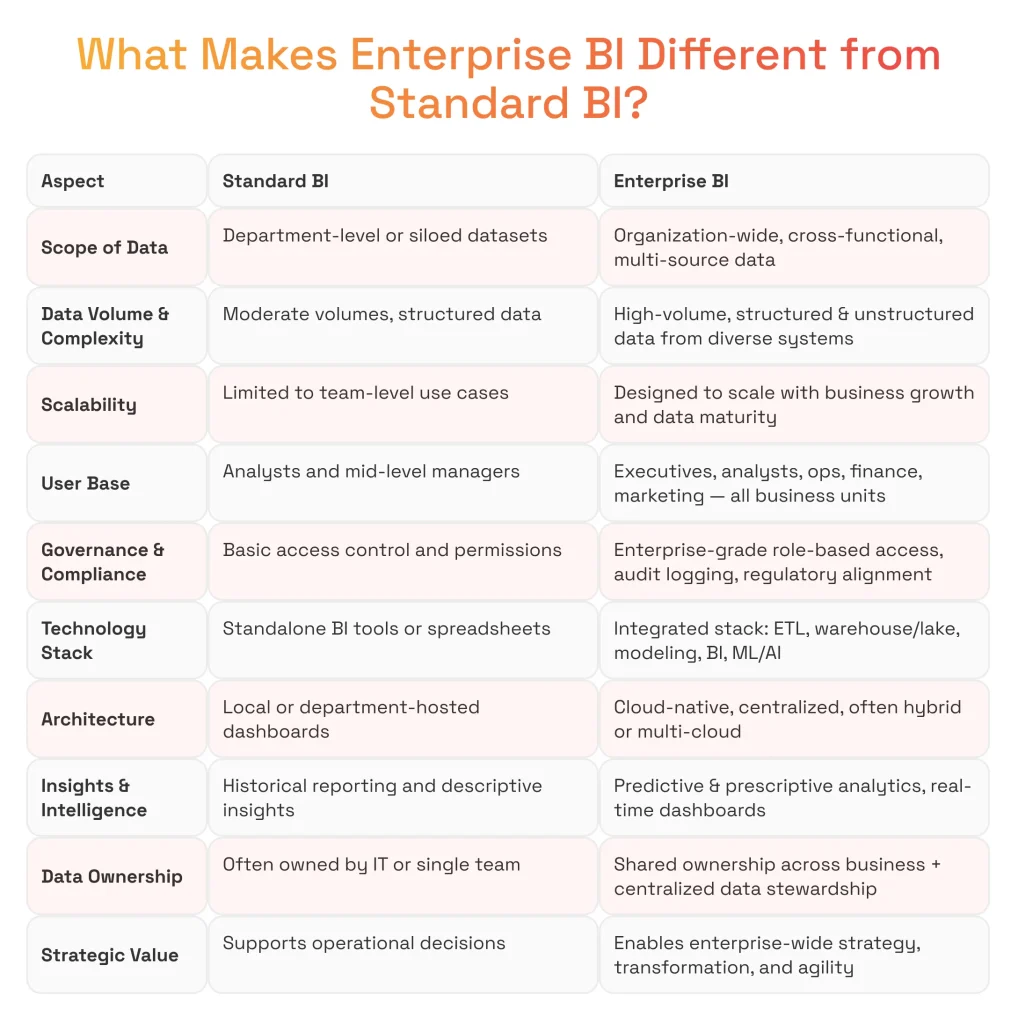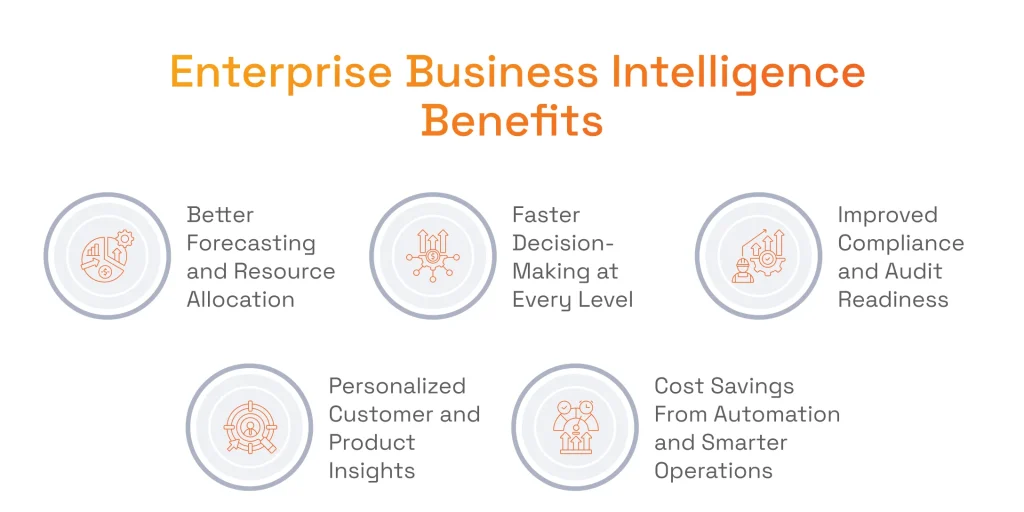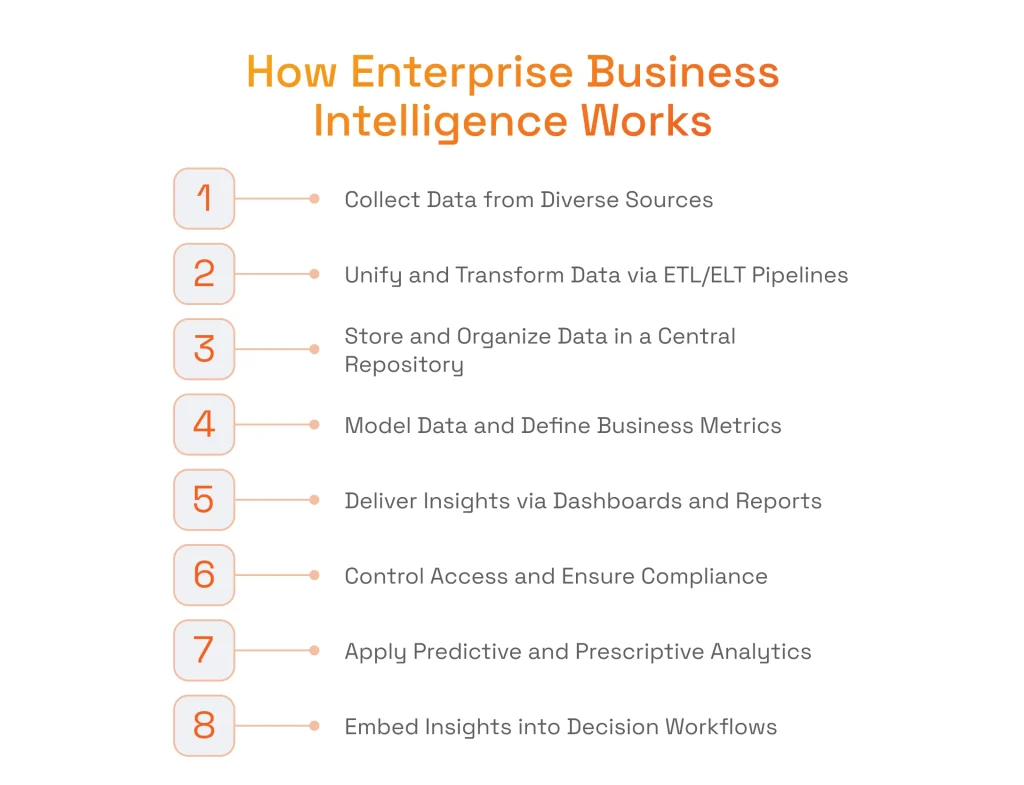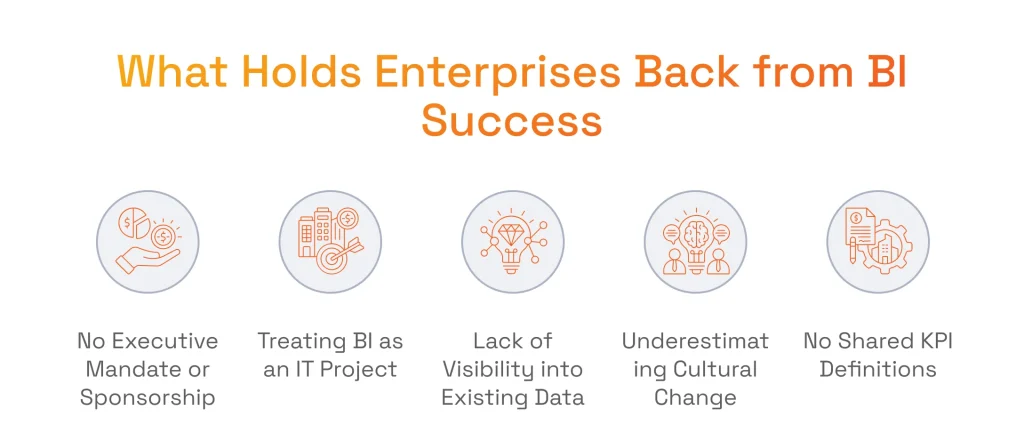Business Intelligence (BI) has gained traction across various niches, including e-commerce, insurance, IT and beyond. Due to its ability to accelerate processes and help achieve strategic goals, medium and large-sized enterprises, in particular, are among the leading adopters of BI tools and solutions. This has influenced the global BI market, which is growing rapidly, from $31,98 billion in 2024 to $63,20 billion in 2032 (with a CAGR of 8,9%). And it isn’t just about new technology, it’s a sign that your competitors are already acting on data.
Enterprise business intelligence fills the gaps, offering real-time visibility, actionable insights and predictive foresight. Taking the fact that modern corporate BI is no longer just about dashboards, you can get integration with AI, automation and predictive analytics which in turn can become a strategic layer that touches every part of your company. Organizations that delay BI adoption risk falling behind, as others move faster and transform raw data into actionable insights and sharper, evidence-based decisions.
What Is Enterprise Business Intelligence?
Speaking about enterprise business intelligence, experts mean applying comprehensive strategies, methodologies, tools and processes that help collect, integrate, analyze and present business data across an entire organization. Specifically, Enterprise BI improves:
- Data Integration: if you bring together data from multiple departments and systems into one cohesive framework, you get better insights.
- Processes: so you get accurate, real-time data from all levels of the enterprise, ensuring that leaders and teams can make more informed choices and eventually improve internal and external processes.
- Efficiency: if you require support in decision-making, you can get it through automation, predictive analytics and data visualization (you will operate more efficiently by reducing manual data handling).
- Cross-Department Collaboration: this is about the ability to integrate and analyze data across various functions, breaking down silos and helping departments work more collaboratively towards shared goals.
What Makes Enterprise BI Different from Standard BI?
In contrast to standard systems, typically used by startup teams or individual departments, enterprise business intelligence platforms are built for complexity and cross-functional integration. As organizations expand, so does the volume of your data and operations.

So, for leadership roles like CTOs or CEOs, the ability to access accurate, real-time insights across all departments becomes a strategic necessity. Enterprise business intelligence (BI) provides this capability, supporting both short-term and long-term strategic planning. Here’s what else sets Enterprise solutions apart:
- Scale and Complexity of Data: as we mentioned above, the approach handles vast amounts of data from various sources, ensuring that insights you gain are comprehensive and reflect the entire organization.
- Multi-Departmental Access and Governance: you get a unified enterprise business intelligence platform where different departments and teams can quickly access relevant data while maintaining strict governance and security protocols.
- Real-Time, Predictive and Prescriptive Capabilities: beyond historical analysis, you can find real-time dashboards, get prescriptive analytics and see predictive recommendations for the next steps.
- Integration with ERP, CRM, Cloud Data Platforms and AI Workflows: you can be sure that data from various systems like ERP (Enterprise Resource Planning), CRM (Customer Relationship Management) are brought together into one unified system, so you can get a view of your organization’s operations, track and analyze data from various departments.
A successful implementation of enterprise business intelligence requires a forward-thinking approach.
If you’re ready to take the next step, explore the essential components of enterprise data strategy in our dedicated guide!
The Competitive Edge of Using Enterprise Business Intelligence (BI)
As the concept of Big Data rises and modern technologies are generating vast amounts of information, we now require advanced tools with cloud computing infrastructure benefits to process and analyze it. Unfortunately, standard programs such as Excel cannot manage such massive data volumes.

So, by deploying and implementing enterprise business intelligence solutions, you can gain the following advantages:
- Better Forecasting and Resource Allocation: you can apply predictive analytics to enable your team to foresee market trends and allocate resources efficiently.
- Faster Decision-Making at Every Level: as we mentioned above, the real-time data access ensures that decisions are based on the most current information available.
- Improved Compliance and Audit Readiness: you can focus on comprehensive data tracking and reporting, facilitating compliance with regulatory standards and simplifying audit processes.
- Personalized Customer and Product Insights: with the detailed analytics, you get marketing strategies and product development based on customer behavior and preferences.
- Cost Savings from Automation and Smarter Operations: by automating data collection and analysis, you may reduce manual labor that will also minimize errors and eventually lead to significant cost reductions.
With the rise of AI and data analytics, companies across various sectors are transforming their operations. One of the examples is HaulHub, which used AI and data to make significant advancements in the transportation and construction niche. As the result of our long-term collaboration with this company, we developed an all-in-one business intelligence platform that consolidates data from transportation agencies, suppliers and vendors into a single dashboard, providing instant visibility and smooth collaboration among stakeholders.
How Enterprise Business Intelligence Works
The enterprise business intelligence systems aggregate large volumes of data from various sources, process it and deliver insights that help leaders and teams understand performance and identify trends. Actually, the business impact of Big Data is significant here, as it enables companies to analyze everything from customer behaviors to their pain-points, preferences and needs.

In this way, BI applications transform information into meaningful data which helps businesses understand the processes better. Enterprise systems usually include several interconnected components that work together to transform raw data into actionable insights:
1. Data Sources: The Starting Point of BI
Enterprise Resource Planning and Customer Relationship Management are often integrated with enterprise business intelligence software to provide a more comprehensive view of the operations. So data is collected from these various sources, like ERP and CRM internal systems, as well as external sources such as market trends and social media. Collected data is then ingested and integrated into a centralized system, ensuring consistency and accuracy across the organization. There are three main types of data:
- Unstructured Data: this usually includes text documents, videos and other information that can’t be easily read or organized by computers (a large portion of internet data, such as social media posts or customer reviews, is unstructured).
- Structured Data: data that’s organized in fixed formats, such as names, addresses or sales figures, making it easy to store and query using software tools.
- Semi-Structured Data: it is a bit of a mix between structured and unstructured data.
2. Data Ingestion & Integration
The next step is to collect data, which you will then ingest and integrate into the BI system to ensure accuracy across various data sources. Experts usually use the Extract, Transform and Load (ETL) technique. It is also about the the importance of data integration process that involves:
- extracting data from various sources we mentioned above (databases, flat files, APIs or other storage mechanisms).
- once the data is extracted, it often needs to be transformed into a format suitable for analysis/reporting (this is our step: data ingestion and integration), and then goes load.
3. Centralized Data Storage (Data Warehouse/Data Lake/Lakehouse)
Integrated data is stored in centralized repositories like enterprise data warehouse or data lakes/lakehouse, facilitating easy access and analysis. Before data is used for analysis, it typically undergoes several transformation steps to improve quality and usability. The transformation of data here can also involve various operations:
- Cleaning the data (e.g., correcting errors)
- Enriching the data (like combining it with other sources)
- Summarizing data
- Converting types or formats
- Applying rules or calculations.
4. Data Modeling & Semantic Layer
Data modeling involves structuring the data to reflect business processes, while the semantic layer provides a user-friendly interface for data interaction. It means that you get data modeling with organized raw data to see real-world business processes, defining relationships, hierarchies and metrics for easier analysis. It ensures the data structure reflects how a business operates.
At the same time, the semantic layer simplifies data access by translating complex datasets into familiar business terms. This way, you can help non-technical users understand insights and interact with the data without needing to understand database structure. This layer bridges the gap between technical data models and business users.
5. BI Tools & Dashboards
The enterprise business intelligence tools help visualize complex data through interactive dashboards and reports, making it easier for users to understand trends, patterns and key metrics. This visualization turns raw data into actionable insights. Here are some top Enterprise Business Intelligence solutions to research:
- Power BI: it provides interactive data visualizations and business intelligence capabilities.
- Tableau: you can find here drag-and-drop analytics that creates real-time visualizations and analyzes complex datasets.
- Google Data Studio: it is actually a free tool for creating customizable reports and dashboards, possible to integrate with other Google products.
6. Governance, Access Control, and Security
Implementing strict governance and security measures is about ensuring that data is protected. Access is granted based on user roles and responsibilities:
- Governance: it establishes data ownership, standards and policies.
- Access Control: you get role-based access that ensures users only see data relevant to their responsibilities (you can use tools like Active Directory and Azure AD).
- Security: it involves encryption (at rest and in transit), audit logging and regular vulnerability assessments.
The success of your data strategy largely depends on how well it is managed. You need to be sure that your data is accurate, accessible and secure across all systems.
To get a better understanding of best practices for enterprise data management, check out our ultimate guide!
7. Advanced Analytics & Machine Learning
Advanced analytics and machine learning algorithms are applied to predict trends and identify patterns. It actually involves the use of sophisticated techniques to analyze historical data and provide actionable insights. It’s a step beyond traditional BI, which focuses on descriptive data analytics services.
Advanced analytics can also apply predictive and prescriptive analytics. For example, predictive analytics uses historical data to forecast future outcomes. Prescriptive analytics is based on predictive models, but suggests specific actions or decisions to improve outcomes.
8. Insights to Action: BI Embedded into Decision Workflows
Here, the ultimate goal is to apply received insights into daily decision-making processes. So it means integrating Business Intelligence tools and data directly into the day-to-day decision-making processes across the organization. Additionally, data strategy consulting can help you with initial implementation, ensuring that all stakeholders, from top management to operational staff, are involved and trained to use BI tools.
Instead of business leaders and teams having to extract and analyze reports separately, BI insights are readily available within the workflow. For example, in an e-commerce enterprise, customer service teams can access real-time analytics to see which products are trending, allowing them to proactively offer promotions or answer queries. Similarly, HR teams can make decisions based on employee performance data embedded directly within their system.
Dmytro Tymofiiev
Delivery Manager at SPD Technology
“BI Enterprise isn’t just about dashboards. You can see that it’s about creating a data-driven culture where insights are integrated into every decision-making process of your team.”
What Holds Enterprises Back from BI Success
Despite the clear benefits, several challenges can be faced during an implementation of BI enterprise methodology, especially at early-stages. Below are some of the most common ones along with the solutions we, at SPD Technology, offer our customers to ensure BI implementation success.

- No Clear Executive Mandate or Sponsorship: we work closely with leadership to secure a clear executive mandate from the start. A successful initiative needs strong support, so we help define a shared vision, clarify priorities and ensure commitment as a solid foundation for BI projects success right from day one.
- Treating BI as an IT Project, Not a Business Initiative: our approach emphasizes the strategic business value of BI, ensuring cross-departmental collaboration. What does it mean? Our efforts with strategic goals bring business and technical teams together, we build a collaborative framework that reflects the organization’s real priorities.
- Data Chaos or Lack of Visibility into What’s Already Available: let’s say, we make comprehensive data audits to identify existing data assets and help with data management to avoid chaos. When data is outdated or poorly documented, the real insights are hard to reach, so we begin with a full data audit, cataloging what already exists, identifying gaps and setting up centralized data access.
- Underestimating the Cultural Shift Required: upskilling employees is crucial, so we provide dedicated consultants to bridge BI expertise gaps and start training within management support. Such guidance can help build data literacy and culture, strengthening a company-wide commitment to data-driven decisions.
- No Shared Understanding of KPIs or What Success Looks Like: at the end, it is crucial to highlight that we lead interactive workshops to define clear KPIs and success metrics aligned with business objectives. We work with stakeholders and ensure that every team is aligned on what value looks like.
Looking for a reliable partner to empower a strategic BI implementation for your enterprise?
Take a look at our curated list of the best business intelligence consulting companies!
The Future of Enterprise Business Intelligence – Tapping into Opportunities Now
Now let’s talk about how to turn data into action because the future of enterprise business intelligence isn’t just about dashboards. It’s about proper enterprise business intelligence strategy and making sure the right people get the right insight exactly when they need it. And then actually doing something with it.
Modern enterprise BI systems are not only about engines. Instead of just showing what happened last quarter, they also highlight trends, suggest what’s likely to happen next and even recommend steps to take. This is where AI and machine learning expertise come in first.
Moving Toward AI-Augmented and Action-Oriented BI
The integration of Artificial Intelligence into BI systems is enhancing analysis and already transforming how enterprises analyze data. Such tools help by offering advanced capabilities like Artificial Intelligence for customer behavior analysis, allowing businesses to predict users preferences and personalize experiences based on large sets of behavioral data. The AI-driven tools also help:
- Spot patterns in your data
- Predict what might happen next
- Suggest actions (not just insights)
- Automate responses in some cases.
Data Culture Will Outperform Data Volume
Organizations that cultivate a strong data culture, where data is accessible and actually used consistently, will outperform those that focus solely on data accumulation. Just having a lot of data doesn’t guarantee success. What matters more is how well your company can:
- Give people access to data
- Ensure the data is trustworthy
- Encourage employees to actually rely on it.
In other words, companies with a strong data culture will do better. Also, AI for Business Intelligence can help businesses enhance operational efficiency by automating repetitive tasks and providing predictive insights from large datasets, freeing up resources for more creative and strategic tasks.
Capturing the Opportunity Requires a Strategic Partner
Implementing enterprise BI software is incredibly complex. It requires strategic planning and execution with reliable partners. The practice usually involves:
- Understanding your goals
- Aligning different teams
- Choosing the right tools
- Managing the change it brings.
An enterprise business intelligence partner like SPD Technology can guide you through such processes, delivering all of the advantages of strategic technology consulting. We make sure your BI setup is not just functional, but truly supports long-term business value.
Final Thoughts
For enterprises, Business Intelligence isn’t just a tool. Instead, it becomes a strategic necessity, opening up a reliable path to sustainable growth. It enables cross-departmental alignment and faster decision-making at a higher level of confidence, being supported by real-time and relevant data.
However, implementing scalable enterprise business analytics solutions aligned with your company’s goals is rarely straightforward. It requires more than software—it demands the right strategy, technical expertise, and a cultural shift toward data-driven thinking. At SPD Technology, we help enterprises make that shift with confidence. From BI strategy to full-scale implementation, we partner with you to turn complexity into clarity.
Get in touch with us to start turning data into impactful decisions!
FAQs
How can Enterprise BI support digital transformation?
Enterprise BI provides the data-driven insights, tools and methodology that are necessary for digital transformation. It enables organizations to make informed decisions while improving operations and processes.
Is cloud-based Enterprise BI better than on-premise solutions?
As cloud-based BI means your tools and data are hosted on external platforms like AWS or Google Cloud, and you access everything online. On-premise BI, on the other hand, runs entirely on your own company’s servers and infrastructure, giving you full control over data and more security. Cloud BI is often seen as more flexible and cost-efficient, which makes it attractive to many companies. However, the best option depends on your specific business requirements/existing IT setup.
How is Enterprise BI different from regular BI?
When we speak about Enterprise BI, we mean a broader scope of integrating data. It connects and integrates data across the entire organization, enabling company-wide visibility and collaboration. It provides advanced analytics capabilities, whereas regular BI may focus on small or specific departments or functions. Also, Enterprise BI platforms typically offer more advanced features like centralized data governance, enterprise-scale data modeling, cross-functional dashboards and support for AI.
